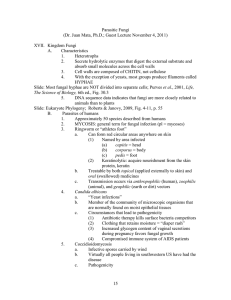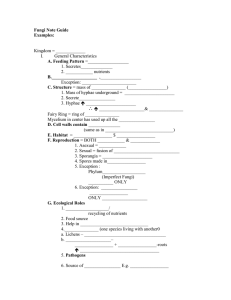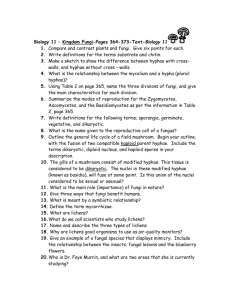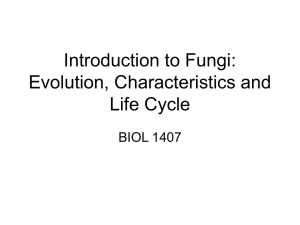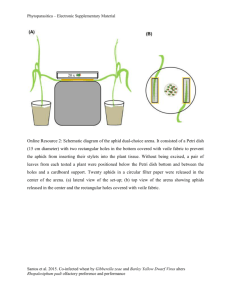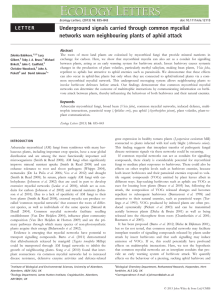Vegetables employ fungi to carry messages between them Plant communications Beans’ talk
advertisement
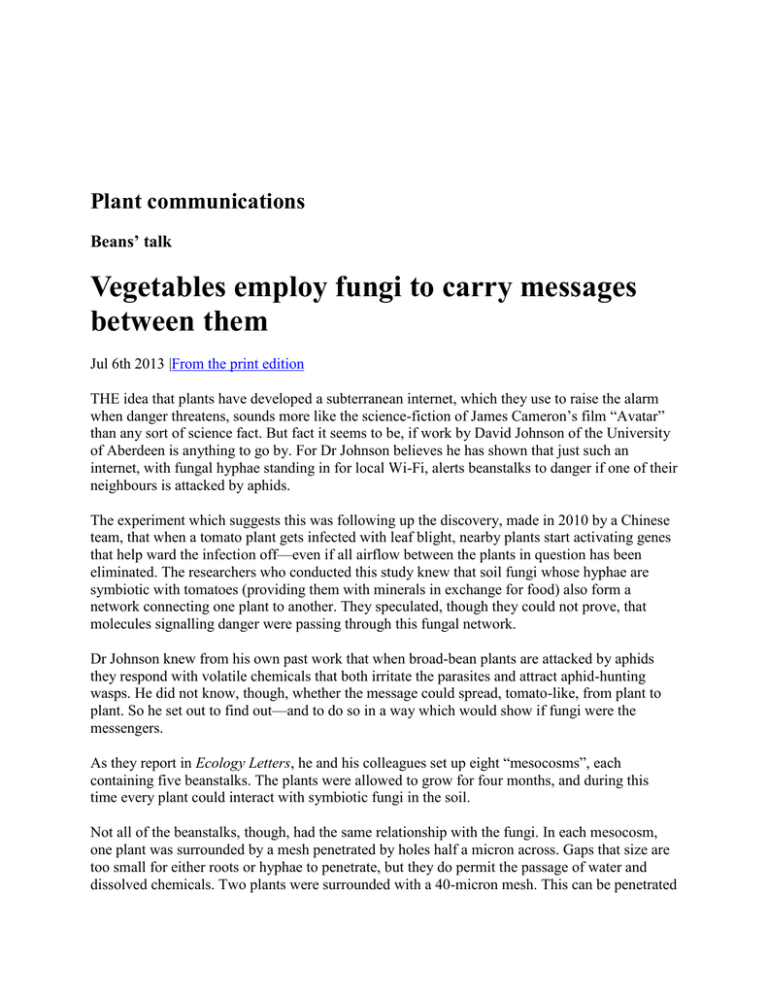
Plant communications Beans’ talk Vegetables employ fungi to carry messages between them Jul 6th 2013 |From the print edition THE idea that plants have developed a subterranean internet, which they use to raise the alarm when danger threatens, sounds more like the science-fiction of James Cameron’s film “Avatar” than any sort of science fact. But fact it seems to be, if work by David Johnson of the University of Aberdeen is anything to go by. For Dr Johnson believes he has shown that just such an internet, with fungal hyphae standing in for local Wi-Fi, alerts beanstalks to danger if one of their neighbours is attacked by aphids. The experiment which suggests this was following up the discovery, made in 2010 by a Chinese team, that when a tomato plant gets infected with leaf blight, nearby plants start activating genes that help ward the infection off—even if all airflow between the plants in question has been eliminated. The researchers who conducted this study knew that soil fungi whose hyphae are symbiotic with tomatoes (providing them with minerals in exchange for food) also form a network connecting one plant to another. They speculated, though they could not prove, that molecules signalling danger were passing through this fungal network. Dr Johnson knew from his own past work that when broad-bean plants are attacked by aphids they respond with volatile chemicals that both irritate the parasites and attract aphid-hunting wasps. He did not know, though, whether the message could spread, tomato-like, from plant to plant. So he set out to find out—and to do so in a way which would show if fungi were the messengers. As they report in Ecology Letters, he and his colleagues set up eight “mesocosms”, each containing five beanstalks. The plants were allowed to grow for four months, and during this time every plant could interact with symbiotic fungi in the soil. Not all of the beanstalks, though, had the same relationship with the fungi. In each mesocosm, one plant was surrounded by a mesh penetrated by holes half a micron across. Gaps that size are too small for either roots or hyphae to penetrate, but they do permit the passage of water and dissolved chemicals. Two plants were surrounded with a 40-micron mesh. This can be penetrated by hyphae but not by roots. The two remaining plants, one of which was at the centre of the array, were left to grow unimpeded. Five weeks after the experiment began, all the plants were covered by bags that allowed carbon dioxide, oxygen and water vapour in and out, but stopped the passage of larger molecules, of the sort a beanstalk might use for signalling. Then, four days from the end, one of the 40-micron meshes in each mesocosm was rotated to sever any hyphae that had penetrated it, and the central plant was then infested with aphids. At the end of the experiment Dr Johnson and his team collected the air inside the bags, extracted any volatile chemicals in it by absorbing them into a special porous polymer, and tested those chemicals on both aphids (using the winged, rather than the wingless morphs) and wasps. Each insect was placed for five minutes in an apparatus that had two chambers, one of which contained a sample of the volatiles and the other an odourless control. The researchers found, as they expected from their previous work, that when the volatiles came from an infested plant, wasps spent an average of 3½ minutes in the chamber containing them and 1½ in the other chamber. Aphids, conversely, spent 1¾ minutes in the volatiles’ chamber and 3¼ in the control. In other words, the volatiles from an infested plant attract wasps and repel aphids. Crucially, the team got the same result in the case of uninfested plants that had been in uninterrupted hyphal contact with the infested one, but had had root contact blocked. If both hyphae and roots had been blocked throughout the experiment, though, the volatiles from uninfested plants actually attracted aphids (they spent 3½ minutes in the volatiles’ chamber), while the wasps were indifferent. The same pertained for the odour of uninfested plants whose hyphal connections had been allowed to develop, and then severed by the rotation of the mesh. Broad beans, then, really do seem to be using their fungal symbionts as a communications network, warning their neighbours to take evasive action. Such a general response no doubt helps the plant first attacked by attracting yet more wasps to the area, and it helps the fungal messengers by preserving their leguminous hosts. Plant-fungus symbiosis is a surprisingly underexplored area of biology. The limited data available suggest most plants go in for it in one form or another, but its role is only slowly being illuminated. Work like Dr Johnson’s suggests this is a serious omission, not least for the understanding of how crops like beans actually grow. The underground world, though invisible to the human eye, should not for that reason be ignored or underestimated. From the print edition: Science and technology
